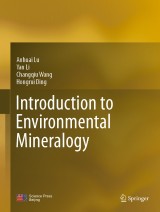Details

Introduction to Environmental Mineralogy
|
223,63 € |
|
| Verlag: | Springer |
| Format: | |
| Veröffentl.: | 22.05.2023 |
| ISBN/EAN: | 9789811977923 |
| Sprache: | englisch |
Dieses eBook enthält ein Wasserzeichen.
Beschreibungen
<p>This book focuses on the environmental property of minerals including mineralogical record of environmental changes, mineralogical influence on the environmental quality, mineralogical evaluation of the environment, mineralogical processing of environmental pollutants and interaction between minerals and microbes. Understanding of the environmental property of minerals is a good supplement to the traditional concept of “mineral”. </p><p>By demonstrating plenty of case studies with easy-to-understand figures and tables, this book introduces the environmental effects of interaction between minerals and microbes, physiological and ecological effects of biomineralization, reductive precipitation property of iron sulfide minerals, photocatalytic reduction property of sphalerite, photocatalytic oxidation property of rutile, tubular structure property of chrysotile, tunnel structure property of K-feldspar tetrahedron, tunnel structure property of cryptomelane octahedron, nano property of cryptomelane, crystallization property of jarosite, interaction between semiconducting minerals and microbes, pathological mineralization of human body, mineralogical processing of inorganic pollutants, mineralogical degradation of organic pollutants, mineralogical purification of smoke-type pollutants, mineralogical evaluation of soil environmental quality, mineralogical prevention and control of waste pollutants and mineralogical processing of mine tailings. </p><p>The book is written for environmental mineralogist as well as postgraduates majoring in environmental science. </p>
<div><p>Chapter 1 Environmental Property of Minerals-1205.- Chapter 2 Environmental Effects of Tunnel Structure Minerals-0113.- Chapter 3 Photoactivity of Mn Oxides on Earth’s Surface-1230.- Chapter 4 Redox Activity of Iron Sulfide and Mn Oxide-0106.- Chapter 5 Interaction Between Fe & Mn-Bearing Minerals and Microbes-1230.- Chapter 6 Photocatalytic reduction effects of sphalerite and native sulfur-1213.- Chapter 7 Photocatalytic oxidation effects of rutile-1213.- Chapter 8 Interactions between Semiconducting Minerals and Microbes-1209.- Chapter 9 Human Pathological Mineral Features-1213.- Chapter 10 Infrared Effect of Minerals-0107</p><br></div>
<p>Professor Anhuai Lu graduated from Peking University in 1984, with the Bachelor of Geology and he obtained his PhD of mineralogy from China University of Geosciences (Beijing) in 1993. Starting from 2000, he works as Professor in School of Earth and Space Sciences, Peking University. He is the President of International Mineralogical Association (IMA). He is currently on the editorial board of several journals such as “Elements” and “Journal of Mineralogical and Petrological Sciences”. He is the chairman of Environmental Mineralogy Committee affiliated to Chinese Society of Mineralogy, Petrology and Geochemistry and also the vice chairman of Mineralogy Committee affiliated to Geological Society of China. His research field focuses on Environmental mineralogy. He has published more than 100 papers in many peer-reviewed journals as the main author or co-author, covering <i>Nature Communication</i>, PNAS, as well as <i>Elements</i>.</p><p><br></p><p>Yan Li, Associate professor, graduated from China University of Geosciences (Wuhan) in 2003, with the Bachelor of Gems & Materials Technology and she obtained her PhD of Materials & Environmental Mineralogy from Peking University in 2008. She was promoted as associate professor in 2012 in School of Earth and Space Sciences, Peking University. She is vice chair of the Mineral Informatics Working Group of the International Mineralogical Association (IMA), a member of Mineralogical Society of Europe and a member of Environmental Mineralogy Committee affiliated to Chinese Society of Mineralogy, Petrology and Geochemistry. Her research field covers environmental mineralogy, interaction between minerals and microbes, co-evolution of minerals and microbes, etc. She has published more than 30 80 papers in many peer-reviewed journals as the main author or co-author<br></p>Changqiu Wang, Associate professor, graduated from Peking University in 1986, with the Bachelor of Petrology, Mineralogy and Geochemistry and he obtained his PhD of Petrology from Peking University in 1995. He was promoted as associate professor in 1999 in School of Earth and Space Sciences, Peking University. He is a member of the Professional Committee of Environmental Mineralogy, Chinese Society for Mineralogy, Petrology and Geochemistry and a member of the Professional Committee of Genetic Mineralogy and Prospecting Mineralogy, Chinese Society for Mineralogy, Petrology and Geochemistry. His research field focuses on human body mineralization. He has published more than 40 papers in many peer-reviewed journals as the main author or co-author. <br><p></p><p>Hongrui Ding, Associate research fellow, graduated from Peking University in 2008 with the Bachelor of Life Science, and obtained his PhD of Materials & Environmental Mineralogy from Peking University in 2013. His research field focuses on the interaction between mineral and microorganism, microbial extracellular electron transport with semiconductor minerals, environmental effects of mineral photoelectron energy. He has published more than 40 papers in peer-reviewed journals as the main author or co-author.<br></p><p> <br></p><p><br></p>
<p>This book focuses on the environmental property of minerals including mineralogical record of environmental changes, mineralogical influence on the environmental quality, mineralogical evaluation of the environment, mineralogical processing of environmental pollutants and interaction between minerals and microbes. Understanding of the environmental property of minerals is a good supplementary to the traditional concept of “mineral”. </p><p>By demonstrating plenty of case studies with easy-to-understand figures and tables, this book introduces the environmental effects of interaction between minerals and microbes, physiological and ecological effects of biomineralization, reductive precipitation property of iron sulfide minerals, photocatalytic reduction property of sphalerite, photocatalytic oxidation property of rutile, tubular structure property of chrysotile, tunnel structure property of K-feldspar tetrahedron, tunnel structure property of cryptomelane octahedron, nano property of cryptomelane, crystallization property of jarosite, interaction between semiconducting minerals and microbes, pathological mineralization of human body, mineralogical processing of inorganic pollutants, mineralogical degradation of organic pollutants, mineralogical purification of smoke-type pollutants, mineralogical evaluation of soil environmental quality, mineralogical prevention and control of waste pollutants and mineralogical processing of mine tailings. </p><p>The book is written for environmental mineralogist as well as postgraduates majoring in environmental science.</p>
<p>Elaborates on the concept of “Environmental Property of Mineralogy” for the first time</p><p>Addresses interaction between inorganic world “minerals” and organic world “microbes”</p><p>Introduces the mineralogical processing of environmental pollutants</p>
Diese Produkte könnten Sie auch interessieren:

Nitrate, Jodate, Karbonate, Selenite, Tellurite, Manganite, Plumbate

von: Karl F. Chudoba, Carl Hintze

279,95 €
















